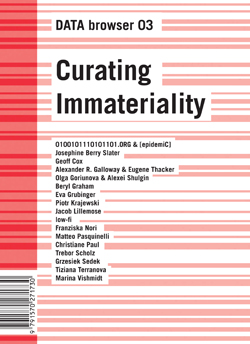Michelle Henning: Museums, Media and Cultural Theory (2005)
Filed under book | Tags: · archive, archiving, art, avant-garde, cultural memory, exhibition, memory, museum

Museums can work to reproduce ideologies and confirm the existing order of things, or as instruments of social reform. Yet objects in museums can exceed their designated roles as documents or specimens. In this wideranging and original book, Michelle Henning explores how historical and contemporary museums and exhibitions restage the relationship between people and material things. In doing so, they become important sites for the development of new forms of experience, memory and knowledge.
Henning reveals how museums can be theorised as a form of media. She discusses both historical and contemporary examples, from cabinets of curiosity, through the avant-garde exhibition design of Lissitzky and Bayer; the experimental museums of Paul Otlet and Otto Neurath; to science centres; immersive and virtual museums; and major developments such as Guggenheim Bilbao, Tate Modern in London and the National Museum of the American Indian in Washington D.C.
Museums, Media and Cultural Theory is unique in its treatment of the museum as a media-form, and in its detailed and critical discussion of a wide range of display techniques. It is an indispensable introduction to some of the key ideas, texts and histories relevant to the museum in the 21st century.
Publisher Open University Press, an imprint of McGraw-Hill International, 2005
Issues in Cultural and Media Studies series
ISBN 0335225756, 9780335225750
183 pages
via Jo Morfin
Sven Spieker: The Big Archive: Art from Bureaucracy (2008)
Filed under book | Tags: · archive, archiving, art, art history, bureaucracy, database, memory, museum, photography, surrealism

“The typewriter, the card index, and the filing cabinet: these are technologies and modalities of the archive. To the bureaucrat, archives contain little more than garbage, paperwork no longer needed; to the historian, on the other hand, the archive’s content stands as a quasi-objective correlative of the “living” past. Twentieth-century art made use of the archive in a variety of ways—from what Spieker calls Marcel Duchamp’s “anemic archive” of readymades and El Lissitzky’s Demonstration Rooms to the compilations of photographs made by such postwar artists as Susan Hiller and Gerhard Richter. In The Big Archive, Sven Spieker investigates the archive—as both bureaucratic institution and index of evolving attitudes toward contingent time in science and art—and finds it to be a crucible of twentieth-century modernism.
Dadaists, constructivists, and Surrealists favored discontinuous, nonlinear archives that resisted hermeneutic reading and ordered presentation. Spieker argues that the use of archives by such contemporary artists as Hiller, Richter, Hans-Peter Feldmann, Walid Raad, and Boris Mikhailov responds to and continues this attack on the nineteenth-century archive and its objectification of the historical process.
Spieker considers archivally driven art in relation to changing media technologies—the typewriter, the telephone, the telegraph, film. And he connects the archive to a particularly modern visuality, showing that the avant-garde used the archive as something of a laboratory for experimental inquiries into the nature of vision and its relation to time. The Big Archive offers us the first critical monograph on an overarching motif in twentieth-century art.”
Publisher MIT Press, 2008
Art: Cultural Studies series
ISBN 0262195704, 9780262195706
219 pages
Reviews: Sas Mays (caa.reviews 2009), Andrew J. Lau (InterActions 2009).
PDF, PDF (updated on 2017-4-22)
Comments (2)Joasia Krysa (ed.): Curating Immateriality: The Work of the Curator in the Age of Network Systems (2006)
Filed under book | Tags: · aesthetics, art, collaboration, curating, database, exhibition, internet, internet art, labour, media art, museum, net art, open source, relational aesthetics, software art, technology

“The site of curatorial production has been expanded to include the space of the Internet and the focus of curatorial attention has been extended from the object to processes to dynamic network systems. As a result, curatorial work has become more widely distributed between multiple agents, including technological networks and software. This upgraded ‘operating system’ of art presents new possibilities of online curating that is collective and distributed — even to the extreme of a self-organising system that curates itself. The curator is part of this entire system but not central to it.
The subtitle of the book makes reference to the essay ‘The Work of Culture in the Age of Cybernetic Systems’ (1988), in which Bill Nichols considered how cybernetics transformed cultural production. He emphasised the shift from mechanical reproduction (symbolised by the camera) to that of cybernetic systems (symbolised by the computer) in relation to the political economy, and pointed to contradictory tendencies inherent in these systems: ‘the negative, currently dominant, tendency toward control, and the positive, more latent potential toward collectivity’. The book continues this general line of inquiry in relation to curating, and extends it by considering how power relations and control are expressed in the context of network systems and immateriality.
In relation to network systems, the emphasis remains on the democratic potential of technological change but also the emergence of what appears as more intensive forms of control. Can the same be said of curating in the context of distributed forms? If so, what does this imply for software curating beyond the rhetoric of free software and open systems?”
Contributors: 0100101110101101.ORG & [epidemiC] | Josephine Berry Slater | Geoff Cox | Alexander R. Galloway & Eugene Thacker | Olga Goriunova & Alexei Shulgin | Beryl Graham | Eva Grubinger | Piotr Krajewski | Jacob Lillemose | low-fi | Franziska Nori | Matteo Pasquinelli | Christiane Paul | Trebor Scholz | Grzesiek Sedek | Tiziana Terranova | Marina Vishmidt
Publisher Autonomedia/I-DAT, 2006
Creative Commons License
DATA browser series, 3
ISBN 1570271739
288 pages
PDF (14 MB, added on 2018-3-29)
PDFs (updated on 2016-12-12)

